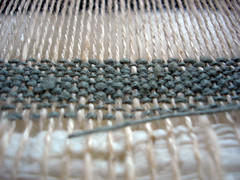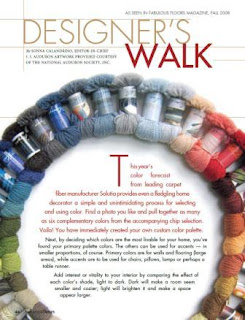 Did you know that carpet as we know it today - i.e., primarily a tufted construction - is the product of a quintessentially American industry? I hadn't until I read Carpet Capital: The Rise of a New South Industry (Economy and Society in the Modern South)
Did you know that carpet as we know it today - i.e., primarily a tufted construction - is the product of a quintessentially American industry? I hadn't until I read Carpet Capital: The Rise of a New South Industry (Economy and Society in the Modern South) . It describes how carpet construction shifted from being woven to tufted in the late 1950s and early 1960s, and from being manufactured in the North to the South.
. It describes how carpet construction shifted from being woven to tufted in the late 1950s and early 1960s, and from being manufactured in the North to the South.
Today, although carpet is still either woven or tufted, over 95% of it is tufted.
A bit of history.
According to Wikipedia, the term 'carpet' also referred to "table and wall coverings as carpets were not commonly used on the floor in European interiors until the 18th century" [beautiful tapestries like The Unicorn Tapestries come to mind]. However, long before that the Turks - who have the longest carpet creation and use history - "protected themselves from the extremes of the cold weather by covering the floors, and sometimes walls and doorways, with carpets." Those carpets were all woven and, when they, and other Oriental carpets, began gracing European interiors in the 15th, 16th and 17th centuries, only appeared underfoot for royalty or statues of the Virgin Mary!
Luckily for all of us, that changed with trade routes opening up and the creation of a middle class of consumers...
2nd Scarf originally uploaded by Brittany No L.
 Woven construction - as we describe it on the Wear-Dated website - has to do with the creation of carpet (or rugs) through a "weaving process on a loom where the lengthwise (warp) yarns and the widthwise (weft or filling) yarns are interlaced to form the fabric. In woven carpet, the face and back are formed at the same time by interweaving warp, weft and other yarns."
Woven construction - as we describe it on the Wear-Dated website - has to do with the creation of carpet (or rugs) through a "weaving process on a loom where the lengthwise (warp) yarns and the widthwise (weft or filling) yarns are interlaced to form the fabric. In woven carpet, the face and back are formed at the same time by interweaving warp, weft and other yarns."
This is the same process used to weave sheets or apparel fabrics, including the scarf shown in the photo.
Traditional woven carpet styles include Axminster, Wilton - traditionally made in the U.K. - and velvet. In the U.S., Karastan is one of the largest carpet weavers.
[Do read this excellent description of Woven Carpet by Tom Cartmell, CFI Chairman of Industry Relations Committee.]
As mentioned above, the majority of carpet manufactured and sold in this country is tufted. Here's how
Wear-Dated describes tufted construction.
For tufted carpet, "yarn gets tufted into a primary backing [a woven or non-woven fabric in which tufting needles insert pile yarn – that’s what creates the fuzzy side] which then gets glued or laminated to a secondary backing that reinforces and increases dimensional stability. That glue or latex coating also locks the fibers into place."
[In
Carpet Construction Basics, Carpet Quality and Performance, Michael Hilton likens tufting to embroidery.]
Once manufactured, the carpet surface will have a 'fuzzy' look to it because the pile won't be perfectly level and neat. At that point, it will go into a "sheering machine which shaves off those variations to create a nice, smooth finished carpet."
The tufting construction process for carpet is an extremely versatile one in that many different styles of carpet are possible. I'll review those in the next installment of
Understanding Carpet.
Other carpet construction resources:
Previous posts in this series include:
Understanding Carpet: QualityUnderstanding Carpet: Benefits
Technorati Tags:
carpet construction Wear-Dated woven carpet tufted carpet carpet history Karastan Del.icio.us Tags:
carpet construction Wear-Dated woven carpet tufted carpet carpet history Karastan
 The Carpetology Blog turns one today. I'm excited beyond belief. I'm also tremendously grateful to you for making this milestone possible.
The Carpetology Blog turns one today. I'm excited beyond belief. I'm also tremendously grateful to you for making this milestone possible. 


























